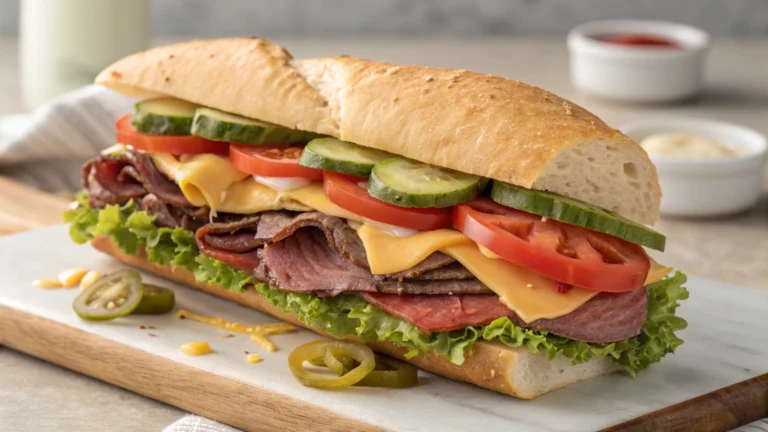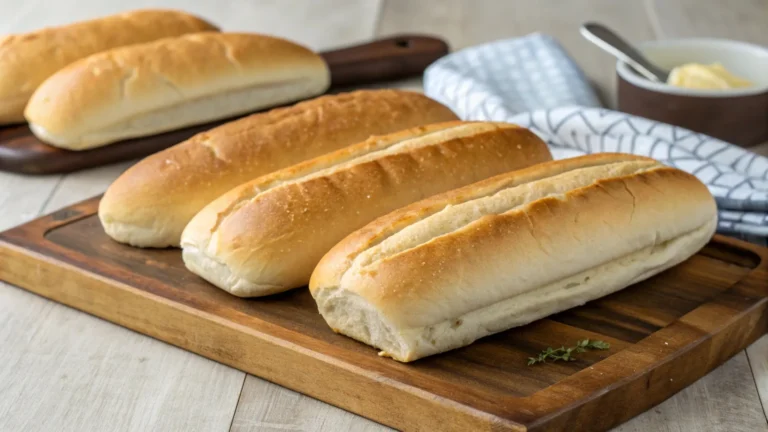Top Smoker Recipes: Easy Ideas for Beginners and Experts

As the sun sets, the smell of smoked meats fills the air. It’s exciting to learn how to smoke. Whether you’re new or experienced, smoker recipes have lots of tasty dishes to try.
Try the classic smoker recipe for Dr. Pepper Spare Ribs. Or learn how to smoke fish. This guide will show you how to make delicious, smoky food at home.

Imagine cutting into a wood pellet grill recipes brisket. It’s tender and full of flavor from the wood chips. Or think about your family enjoying best things to smoke on pellet grill like smoked turkey.
This guide will teach you the basics and advanced techniques. You’ll learn how to smoke like a pro, no matter your skill level.
If you’re new to what to smoke or an expert, this guide is for you. Learn about temperature, wood, and flavor to make amazing smoked dishes. Get ready to make your backyard a smoky paradise of flavors.
Table of Contents
Essential Smoking Equipment and Setup Guide
Smoking food is a traditional cooking method that adds deep flavors to dishes. To get good at smoking, you need the right tools and setup. This includes picking the best wood chips and keeping the temperature just right. Let’s explore what you need to set up your smoker for success.
Choosing the Right Wood for Different Meats
The wood you choose can greatly affect the taste of your smoked food. Different woods give different flavors. For example, oak and hickory are good for strong meats like beef brisket and pork ribs. On the other hand, apple and cherry woods are better for lighter meats like chicken and fish.
Temperature Control Basics
Keeping the right temperature is key when smoking. The best temperature for smoking is between 225°F and 275°F. This slow cooking method helps the meat soak up smoky flavors and become tender. Use a meat thermometer to check the meat’s internal temperature and get consistent results.
Must-Have Smoking Tools and Accessories
- Smoker (charcoal, electric, or pellet-fueled)
- Wood chips or chunks (such as oak, hickory, or apple)
- Meat thermometer
- Heat-resistant gloves
- Basting brush
- Drip pan
- Tongs and spatula
- Fuel source (charcoal, propane, or wood pellets)
- Lighter or chimney starter
With the right wood, temperature control, and tools, you’re ready to make amazing smoked dishes. These dishes will surely impress your loved ones. Remember, the secret to great smoking is patience, careful attention, and a love for the craft.
Low and Slow Smoking Techniques for Perfect Results
Smoking meats low and slow is the secret to tender, flavorful results. By learning this technique, you can impress your friends and family with delicious dishes.
Keeping the temperature between 225°F and 250°F is crucial. This slow cooking lets the smoke deeply flavor the meat. It’s a method that beats other cooking ways.
Try the two-zone fire setup for better results. It has a hot zone for searing and a cool zone for slow cooking. This method helps keep the temperature steady, ensuring your meats are always perfect.
- Experiment with different wood chips, such as hickory, mesquite, or apple, to add unique layers of flavor to your smoked meats.
- Consider spritzing your meat with a vinegar-based solution during the smoking process to help retain moisture and enhance the overall flavor profile.
- Wrap your meat in foil or butcher paper during the latter stages of cooking to “wrap” the smoke and juices, resulting in a tender, flavorful finish.
Mastering low and slow smoking will make your smoked meats stand out. It takes patience and detail, but the results are worth it.
Classic Smoker Recipe: Dr. Pepper Spare Ribs
Take your barbecue to the next level with this Dr. Pepper Spare Ribs recipe. It’s perfect for the smoker. The dish combines a tasty dry rub, slow smoking, and a tangy Dr. Pepper glaze. It’s a flavor explosion that will wow your guests.
Preparation and Seasoning Steps
Begin by covering the pork spare ribs with mustard. This helps the dry rub stick better. Mix brown sugar, barbecue rubs, garlic powder, onion powder, smoked paprika, and spices in a bowl. Spread this mix evenly over the ribs, making sure to massage it in for full coverage.
Smoking Process and Timing
Heat your smoker to 225-250°F. Place the seasoned ribs on the grates and smoke for 3-4 hours. Wait until the ribs hit 165-175°F inside. Then, wrap them in foil and smoke for 1-2 hours more. This makes the meat tender and easy to pull from the bone.
Glazing and Finishing Touches
Mix Dr. Pepper soda, barbecue sauce, and leftover rub in a saucepan. Simmer until it thickens. Brush the glaze over the ribs. Put the ribs back in the smoker for 15-20 minutes. This caramelizes the glaze, adding a sweet, sticky layer.
Enjoy your Dr. Pepper Spare Ribs hot, with extra glaze for dipping. Serve with your favorite sides for a memorable barbecue feast.
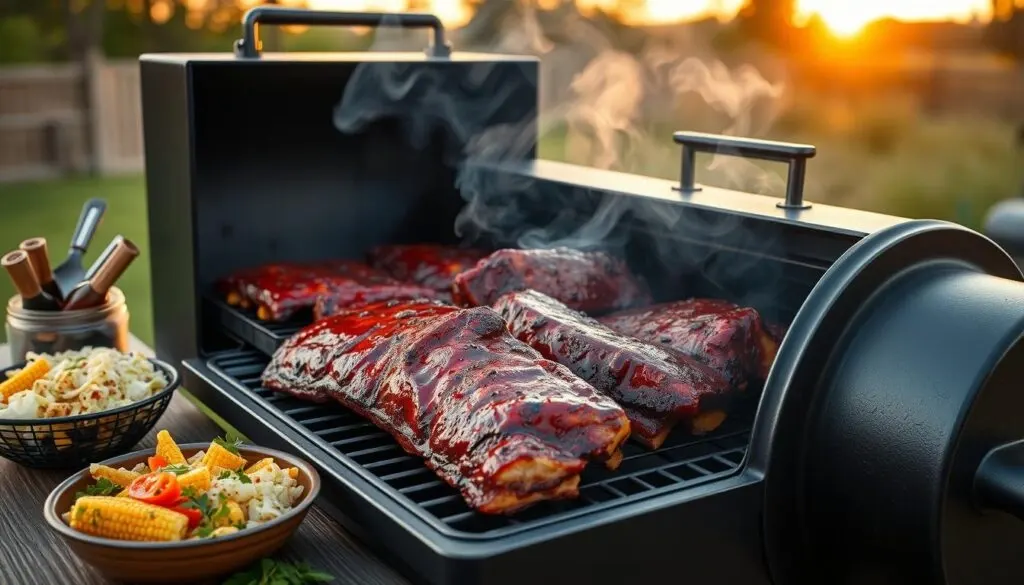
Mastering Smoked Poultry: Chicken and Turkey
Smoking whole chickens and turkeys needs careful technique. Spatchcocking is a key step. It involves removing the backbone and flattening the bird. This makes the meat cook evenly and quickly, resulting in juicy meat and crispy skin.
Choosing the right wood is crucial for smoking poultry. Milder woods like apple or cherry work well. They add a subtle smoke flavor that complements the meat’s natural taste. Keeping the temperature steady between 275-325°F is also important. This ensures the skin is golden and crispy while the inside stays moist and tender.
Applying a dry brine before smoking can add extra flavor. Rub the skin and cavity with a mix of salt, herbs, and spices. Let it sit uncovered in the fridge overnight. This helps season the meat from the inside out and boosts the bird’s juices.
| Smoked Meat | Recommended Smoker Temperature | Cooking Time |
|---|---|---|
| Whole Chicken | 225-275°F | 2-3 hours |
| Turkey Breast | 275-325°F | 2-3 hours |
Patience and attention to detail are key for delicious smoked poultry. By mastering these techniques, you’ll serve up juicy, flavorful chicken and turkey. Your guests will love it.
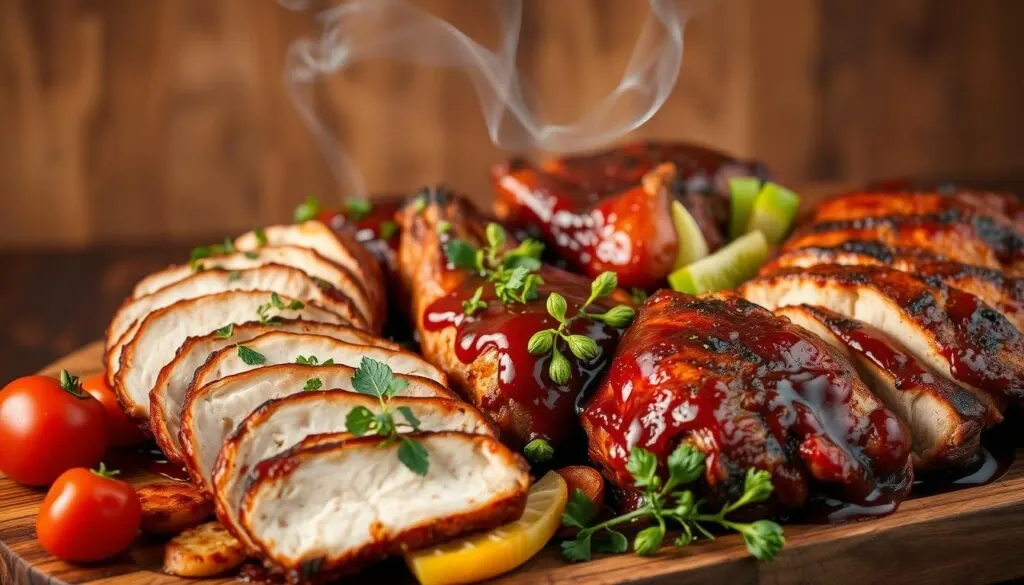
Beef Smoking Mastery: Brisket and Ribs
Smoking beef brisket and ribs is a challenge for any pitmaster. It needs patience, precision, and knowing how to control temperature. This ensures the meat is tender and full of flavor. Whether you’re new to smoking or experienced, we’ll cover the essential techniques for great results.
Dry Rub Techniques
A good dry rub is key to a great smoked beef dish. Mix salt, black pepper, and spices like garlic powder and paprika. Rub this mixture all over the brisket or ribs to season them well. This also helps create a tasty bark on the outside.
Smoking Times and Temperatures
For perfect smoked brisket, keep your smoker at 225°F (107°C). Smoke the brisket for 9 to 12 hours until it hits 203°F (95°C). Ribs are smoked using the 3-2-1 method. This means 3 hours of smoke, 2 hours wrapped, and 1 hour for saucing. Keep an eye on the time to get the meat just right.
Resting and Serving Tips
After reaching the right temperature, let the meat rest before serving. Brisket needs at least 1 hour, but 2 hours is even better. Ribs only need 20 minutes. Slice the brisket against the grain for tenderness. Serve with your favorite sauces and sides.
| Cut | Smoking Temperature | Smoking Time | Resting Time |
|---|---|---|---|
| Brisket | 225°F (107°C) | 9-12 hours | 1-2 hours |
| Ribs | 225°F (107°C) | 3-2-1 method | 20 minutes |
Getting smoked beef right takes patience and attention to detail. Knowing the right times and temperatures is crucial. With these tips, you’ll be a pro at smoking brisket and ribs for your next event.

Quick Weeknight Smoker Recipes
Discover fast and easy smoker recipes for busy weeknights. Enjoy the smoky flavors of meats, poultry, and seafood without spending hours. These recipes are perfect for quick meals.
Try Smoked Chicken Tacos for a quick dinner. Season chicken with a rub, then smoke it on your pellet grill. Use a cast iron griddle for extra smokiness. It cooks in 1.5 to 2 hours, giving you time to prepare the taco fixings.
Our Brown Sugar Smoked Salmon recipe is a hit for a quick dinner. It smokes in about 2 hours, with a sweet brown sugar glaze. Serve it with a salad or roasted veggies for a complete meal.
Smoked Pork Tenderloin is another family favorite. It’s ready in just 2 hours, making it perfect for weeknights. Rub it with spices, then let the smoker do the work. Slice and serve with your favorite sides for a delicious dinner.
Check out our wood pellet grill recipes and what to smoke for more quick and tasty ideas. From smoked chicken wings and salmon to pork chops and burgers, there’s something for everyone.

Advanced Smoking Techniques: Fish and Seafood
Smoking fish and seafood needs a gentle hand. You must learn about brining, controlling temperature, and picking the right wood. These skills are key to making delicious smoked fish dishes.
Brining Methods
Brining is vital for smoking fish and seafood. It adds flavor and keeps the meat moist. You can try wet or dry brines to see what works best for you.
Wet brines soak the fish in a salty solution. Dry brines use a salt and spice rub. Adjust the brine’s strength and soaking time based on the fish’s thickness.
Temperature Control for Delicate Foods
For smoking fish and seafood, keep the temperature low, around 225°F (107°C). This slow heat prevents the proteins from drying out. Check the fish’s internal temperature to ensure it reaches 135°F (60°C) for the best taste and texture.
Stay away from high-heat smoking. It can cook the outside too much while the inside stays raw.
Wood Selection for Fish
The type of wood you use is very important. Choose milder woods like alder, apple, or cherry. They add a sweet, subtle smoke that won’t mask the fish’s flavor. Strong woods like hickory or mesquite are too overpowering.
Try different wood blends to find the perfect smoke flavor for your seafood.
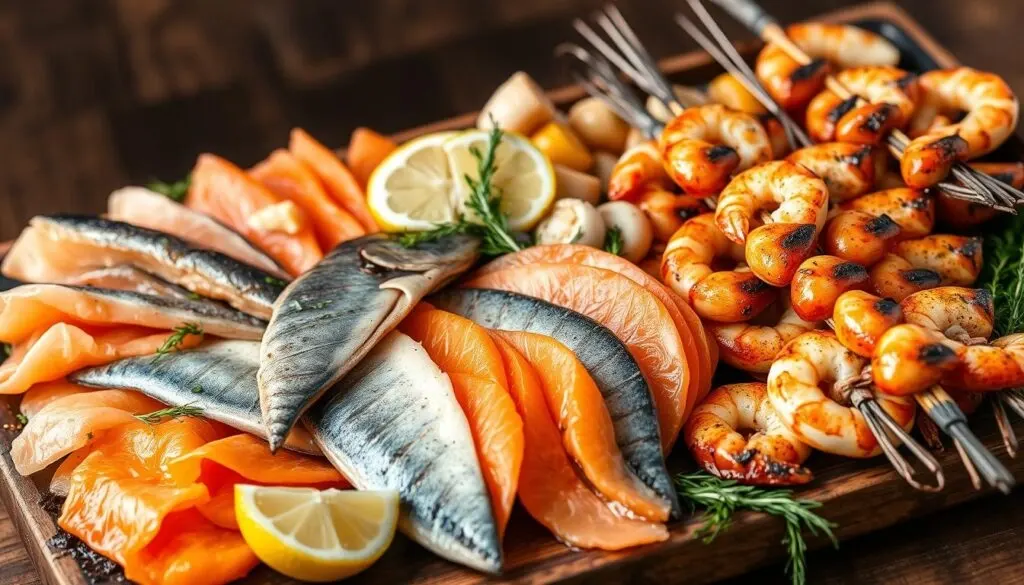
With these advanced techniques, you can make amazing smoked fish and seafood. Experiment with brining, temperature control, and wood selection. This will help you get the most out of your smoker and improve your smoked fish recipes.
Essential BBQ Sauces and Rubs
Make your smoked dishes better with homemade BBQ sauces and rubs. Try the tangy Carolina mustard BBQ sauce, the creamy Alabama white sauce, and the bold vinegar-based sauces from the Carolinas. Also, learn to make versatile dry rubs using common spices and herbs for a flavorful crust on your meats.
If you’re on a low-carb diet, there are keto-friendly BBQ sauce options. They offer great flavor without the added sugars. Mix different rubs and sauces to create unique flavors that will impress your guests.
Homemade BBQ Sauce Recipe
Our homemade barbecue rubs recipe has a 4.79 out of 5 rating from 19 votes. It serves 8 people and is ready in 30 minutes. You’ll need 5 minutes to prepare and 25 minutes to cook.
The recipe includes ketchup, apple cider vinegar, brown sugar, tamari or soy sauce, yellow mustard, garlic powder, cumin, onion powder, and smoked paprika. You can add cayenne pepper, hot sauce, or adobo sauce to customize it.
Store the BBQ sauce in the fridge for up to two weeks or freeze it for up to 3 months. This montreal smoked meat recipe has an average rating of 4.8 out of 5 stars. It’s a must-try for your next barbecue.
Homemade Dry Rubs
Dry rubs add flavor to your smoked meats. Use about 2 tablespoons of rub per 1 1/2 pounds of protein. Homemade rubs can last up to 6 months, while wet rubs last a few weeks in the fridge.
- Experiment with different spice combinations to find your perfect barbecue rubs
- Try a classic blend of brown sugar, chili powder, garlic powder, and smoked paprika
- Add a kick with cayenne pepper or smoked chipotle powder
- Incorporate herbs like thyme, rosemary, or oregano for an earthy touch
Whether you choose a tangy, sweet, or spicy BBQ sauce or create your own dry rub, homemade condiments are key. They help elevate your montreal smoked meat recipe and make your barbecue unforgettable.
Troubleshooting Common Smoking Problems
Smoking meats can be a rewarding journey, but it comes with challenges. Issues like temperature changes and tough meat are common. Knowing the causes and solutions helps ensure delicious results every time.
Managing Temperature Variations
Keeping the temperature steady is key for great flavor and tender meat. Use a high-quality digital thermometer to check your smoker’s temperature. Aim for 225°F to 250°F for most recipes. Adjust vents or add wood as needed to keep it stable.
Preventing Dry or Tough Meat
To avoid dry or tough meat, use the right seasoning and let it sit for a few hours. Proper airflow is also important. If problems persist, try brining or wrapping in butcher paper during smoking.
Avoiding Bitter Flavors
The wood you use greatly affects flavor. Different woods give different tastes. Use lighter woods like apple for chicken and stronger woods like hickory for beef. Keep an eye on smoke levels to avoid bitterness.
Mastering smoking takes practice and patience. By tackling common problems and using the right techniques, you’ll get better at smoking. You’ll be able to produce delicious results every time.
| Smoking Issue | Possible Causes | Recommended Solutions |
|---|---|---|
| Temperature Fluctuations | – Inadequate airflow – Incorrect wood quantity or type – Outdoor temperature changes | – Use a digital thermometer to monitor temperature – Adjust vents to maintain 225°F-250°F range – Experiment with different wood types and quantities |
| Dry or Tough Meat | – Insufficient seasoning – Inadequate moisture during smoking – Overcooking | – Apply seasoning well in advance – Ensure proper airflow and humidity – Wrap meat in butcher paper towards the end |
| Bitter Flavors | – Use of unsuitable wood types – Excessive smoke production | – Choose appropriate wood for the meat type – Monitor smoke levels and adjust accordingly |
Conclusion
Starting your smoking journey is exciting. It takes time and practice to get good at it. This guide has given you a great start to making tasty smoked dishes.
Try different woods like oak, hickory, or applewood. They can change how your dishes taste. Find what you like best.
Your smoker can do more than just barbecue. You can smoke poultry, seafood, veggies, and even cheese. Keep trying new things and don’t be scared to experiment.
Learning to smoke takes patience and a desire to learn. Soon, you’ll make dishes that everyone will love. You’ll impress your family and friends.
The fun of mastering your smoker is just as good as the food. Enjoy the flavors and feel proud of your creations. Happy smoking!
FAQ
What are some top smoker recipes for beginners and experts?
Find recipes for all skill levels. Try Dr. Pepper Spare Ribs, smoked chickens and turkeys. Also, learn advanced techniques for beef brisket, ribs, and fish.
What essential equipment and setup is needed for successful smoking?
Set up your smoker right for great results. Choose the right wood chips or chunks. Keep temperatures between 225°F and 275°F. Use tools like meat thermometers, drip pans, and heat-resistant gloves.
How do I master low and slow smoking techniques for perfect results?
Learn low and slow smoking for tender, flavorful meat. Keep temperatures steady and smoke levels right. Try spritzing and wrapping to keep meat moist and flavorful.
How do I make delicious Dr. Pepper Spare Ribs on a pellet grill?
Start with a mustard base and brown sugar rub. Smoke at low temperatures. Wrap in foil to braise, then glaze with Dr. Pepper for extra flavor.
What techniques are used to smoke whole chickens and turkeys to perfection?
Use spatchcocking for even cooking and smoke penetration. Dry brine overnight for flavor and crisp skin. Try apple or cherry wood for mild smoke flavors.
How do I master smoking beef brisket and ribs?
Make flavorful dry rubs with salt, pepper, and spices. Smoke brisket until it hits 203°F (95°C). For ribs, use the 3-2-1 method or smoke until tender. Let meats rest before slicing to keep juices in.
What are some quick and easy smoker recipes for busy weeknights?
Smoke chicken for tacos on a cast iron griddle. Mix smoking and grilling for fast, tasty meals. Use pre-made rubs and marinades to save time without losing flavor.
How do I master smoking delicate fish and seafood?
Use wet or dry brining to add flavor and keep meat moist. Smoke at lower temperatures, around 225°F. Choose mild woods like alder, apple, or cherry to enhance fish flavors.
How can I create homemade BBQ sauces and rubs to elevate my smoked dishes?
Try regional BBQ sauces like Carolina mustard and Alabama white. Make versatile dry rubs with common spices and herbs. Find keto-friendly BBQ sauce options for low-carb diets.
How do I troubleshoot common issues encountered when smoking meats?
Manage temperature changes, tough meat, and over-smoking. Pick the right wood and amount to avoid bitter flavors. Learn to keep meat moist during long smoking sessions.
Tell us how u found this recipe?
There are no reviews yet. Be the first one to write one.

